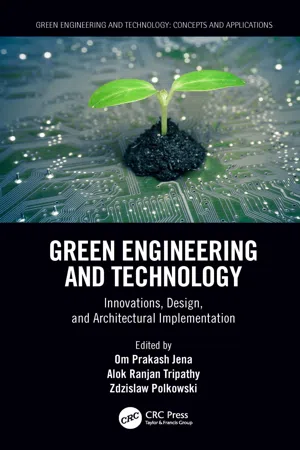
Green Engineering and Technology
Innovations, Design, and Architectural Implementation
- 375 pages
- English
- ePUB (mobile friendly)
- Available on iOS & Android
Green Engineering and Technology
Innovations, Design, and Architectural Implementation
About This Book
Escalating urbanization and energy consumption have increased the demand for green engineering solutions and intelligent systems to mitigate environmental hazards and offer a more sustainable future. Green engineering technologies help to create sustainable, eco-friendly designs and solutions with the aid of updated tools, methods, designs, and innovations. These technologies play a significant role in optimizing sustainability in various areas of energy, agriculture, waste management, and bioremediation and include green computing and artificial intelligence (AI) applications. Green Engineering and Technology: Innovations, Design, and Architectural Implementation examines the most recent advancements in green technology, across multiple industries, and outlines the opportunities of emerging and future innovations, as well as practical real-world implementation.
Features:
-
- Provides different models capable of fulfilling the criteria of energy efficiency, health and safety, renewable resources, and more
-
- Examines recycling, waste management, and bioremediation techniques as well as waste-to-energy technologies
-
- Presents business cases for adopting green technologies including electronics, manufacturing, and infrastructure projects
-
- Reviews green technologies for applications such as energy production, building construction, transportation, and industrialization
Green Engineering and Technology: Innovations, Design, and Architectural Implementation serves as a useful and practical guide for practicing engineers, researchers, and students alike.
Frequently asked questions
Information
1 Cloud and Green IoT-based Technology for Sustainable Smart Cities
CONTENTS
1.1 Introduction
1.2 Smart City Applications and Services
1.2.1 SMART WASTE MANAGEMENT
1.2.2 SMART ENERGY
1.2.3 SMART TRANSPORTATION
1.2.4 SMART WATER MANAGEMENT
1.2.5 SMART HEALTH CARE
1.2.6 SMART BUILDINGS AND LIGHTING
1.2.7 SMART PUBLIC SAFETY
1.2.8 SMART EDUCATION
Table of contents
- Cover
- Half Title
- Series Title
- Title Page
- Copyright Page
- Table of Contents
- Preface
- Editors
- Contributors
- Chapter 1 Cloud and Green IoT-based Technology for Sustainable Smart Cities
- Chapter 2 Dynamic Models for Enhancing Sustainability in Automotive Component Manufacturing Systems
- Chapter 3 Internet of Agriculture Things (IoAT): A Novel Architecture Design Approach for Open Research Issues
- Chapter 4 E-Navigation: An Indoor System for Green City Sustainable Development Using a UGU Engine Architecture
- Chapter 5 Biomass Waste-derived Electrode Material and Bio-based Solid Electrolyte for Sustainable Energy Systems
- Chapter 6 RF Energy Harvesting for WSNs: Overview, Design Challenges, and Techniques
- Chapter 7 Sustainable and Renewable Isolated Microhydropower Generation Using a Variable Asynchronous Generator Controlled by a Fuzzy PI AC–DC–AC Converter and D-STATCOM
- Chapter 8 Phytoconstituents of Common Weeds of Uttarakhand Proposed as Bio-pesticides or Green Pesticides with the Use of In-Silico and In-Vitro Techniques
- Chapter 9 On Energy Harvesting in Green Cognitive Radio Networks
- Chapter 10 Mitigation on the Impact of Electric Vehicle Charging Stations by Splitting the Capacity and Optimally Locating on a Reconfigured RDS
- Chapter 11 Parameter Estimation of a Single Diode PV Cell Using an Intelligent Computing Technique
- Chapter 12 On the Dynamics of Cellular Automata-based Green Modeling toward Job Processing with Group-based Industrial Wireless Sensor Networks in Industry 4.0
- Chapter 13 Green Cloud Computing: An Emerging Trend of GIT in Cloud Computing
- Chapter 14 Internet of Things for Green Technology
- Chapter 15 Green Health: Making Green Healthcare Using Reinforcement Learning in Fog-assisted Cloud Environment
- Chapter 16 Smart Agricultural Robot
- Chapter 17 A Survey of Lightweight Cryptography for Power-constrained IoT Devices: Security Challenges and Issues
- Chapter 18 Nanogenerator-based Sensors for Human Pulse Measurement
- Chapter 19 Future Challenges and Applications in Green Technology
- Chapter 20 Implementation and Use of Green Computing in Polish Companies versus Implementation of Features Characteristic of Teal Organizations
- Chapter 21 Design of a Pentagon Slot-based Multi-band Linear Antenna Array for Energy-efficient Communication: Future Challenges and Applications in Green Technologies
- Index